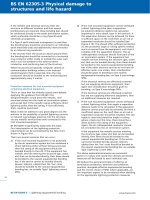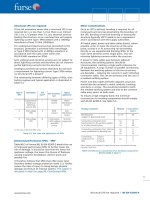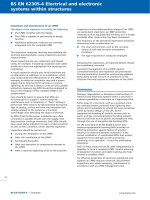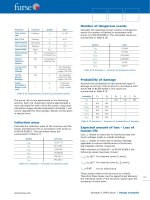Bsi bs en 00451 2 1995 (1999)
Bạn đang xem bản rút gọn của tài liệu. Xem và tải ngay bản đầy đủ của tài liệu tại đây (357.37 KB, 12 trang )
BRITISH STANDARD
Method of testing fly
ash —
Part 2: Determination of fineness by
wet sieving
The European Standard EN 451-2:1994 has the status of a
British Standard
UDC 666.952.2:620.168.32:539.215.4
BS EN
451-2:1995
BS EN 451-2:1995
Committees responsible for this
British Standard
The preparation of this British Standard was entrusted by Technical
Committee B/516, Cement and lime, to Subcommittee B/516/101, Pozzolanas,
upon which the following bodies were represented:
British Aggregate Construction Materials Industries
British Cement Association
British Precast Concrete Federation
British Ready Mixed Concrete Association
Cementitious Slag Makers’ Association
Department of the Environment (Building Research Establishment)
Department of Transport
Electricity Association
Federation of Civil Engineering Contractors
Quality Ash Association
This British Standard, having
been prepared under the
direction of the Sector Board
for Building and Civil
Engineering, was published
under the authority of the
Standards Board and
comes into effect on
15 September 1995
© BSI 12-1999
The following BSI references
relate to the work on this
standard:
Committee reference B/516/101
Draft for comment 91/11364 DC
ISBN 0 580 24528 4
Amendments issued since publication
Amd. No.
Date
Comments
BS EN 451-2:1995
Contents
Committees responsible
National foreword
Foreword
Text of EN 451-2
© BSI 12-1999
Page
Inside front cover
ii
2
3
i
BS EN 451-2:1995
National foreword
This Part of BS EN 451 has been prepared by Subcommittee B/516/101 and is the
English language version of EN 451-2:1994 Method of testing fly ash —
Part 2: Determination of fineness by wet sieving published by the European
Committee for Standardization (CEN). This standard has been prepared as part
of a package of standards harmonized within the member countries of CEN to
support the essential requirements of the Construction Products Directive.
BS EN 451-2 describes a method for the determination of fineness of fly ash by
wet sieving on a calibrated 0.045 mm (45 Èm) sieve as a reference procedure.
The method described in BS EN 451-2 is based on other internationally
recognized standard methods for the determination of fly ash fineness, as is the
method described in Annex D of BS 3892-1:1993.
The importance of checking (calibrating) each test sieve is essential to obtaining
the correct results from this test method. While BS 3892-1 specifies that
calibration be performed with standard reference powders, appropriate to the
grade of ash to be tested, BS EN 451-2 has not made such a stipulation, except
that the reference sample is to consist of rounded sand particles1).
While calibration or recalibration of each test sieve in both standards is made
after 100 tests, BS 3892 requires also that test sieves are re-calibrated
every 3 months, if this is sooner than the maximum of 100 tests permitted. There
are also some minor differences between the two methods, e.g.
a) the pressure of the water supply is specified as (80 ± 5) kPa in
BS EN 451-2, while it is 70 kPa to 80 kPa in Annex D of BS 3892-1:1993;
b) the mass of the sample to be tested is to be approximately 1.0 g in
BS EN 451-2, while it is 1.0 g to 1.1 g in Annex D of BS 3892-1:1993;
c) the determination of the sieve correction factor in BS EN 451-2 is not
required to be repeated if the two determinations differ by more than 0.3 %, as
is required by Annex D of BS 3892-1:1993.
With the exception of the constraint on the maximum of 3 months in use and the
omission of specifying the origin of the calibration powder, any other minor
differences are not considered sufficient to cause significant differences in the test
results obtained by the two methods.
A British Standard does not purport to include all the necessary provisions of a
contract. Users of British Standards are responsible for their correct application.
Compliance with a British Standard does not of itself confer immunity
from legal obligations.
Summary of pages
This document comprises a front cover, an inside front cover, pages i and ii,
the EN title page, pages 2 to 6, an inside back cover and a back cover.
This standard has been updated (see copyright date) and may have had
amendments incorporated. This will be indicated in the amendment table on the
inside front cover.
1)
The source of supply of the reference material will be announced by the Secretariat of
CEN/TC 104, DIN Deutsches Institut für Normung, Burggrafenstrasse 6, D-1000 Berlin 30,
Germany.
ii
© BSI 12-1999
EUROPEAN STANDARD
EN 451-2
NORME EUROPÉENNE
September 1994
EUROPÄISCHE NORM
UDC 666.952.2:620.168.32:539.215.4
Descriptors: Fly ash, determination, fineness, sieving, wet processes
English version
Method of testing fly ash — Part 2: Determination of
fineness by wet sieving
Méthode d’essai des cendres volantes —
Partie 2: Détermination de la finesse par
tamisage humide
Prüfverfahren für Flugasche —
Teil 2: Bestimmung der Feinheit durch
Naßsiebung
This European Standard was approved by CEN on 1994-09-09. CEN members
are bound to comply with the CEN/CENELEC Internal Regulations which
stipulate the conditions for giving this European Standard the status of a
national standard without any alteration.
Up-to-date lists and bibliographical references concerning such national
standards may be obtained on application to the Central Secretariat or to any
CEN member.
This European Standard exists in three official versions (English, French,
German). A version in any other language made by translation under the
responsibility of a CEN member into its own language and notified to the
Central Secretariat has the same status as the official versions.
CEN members are the national standards bodies of Austria, Belgium,
Denmark, Finland, France, Germany, Greece, Iceland, Ireland, Italy,
Luxembourg, Netherlands, Norway, Portugal, Spain, Sweden, Switzerland and
United Kingdom.
CEN
European Committee for Standardization
Comité Européen de Normalisation
Europäisches Komitee für Normung
Central Secretariat: rue de Stassart 36, B-1050 Brussels
© 1994 Copyright reserved to CEN members
Ref. No. EN 451-2:1994 E
EN 451-2:1994
Foreword
This European Standard was drawn up by the
Technical Committee CEN/TC 104, Concrete, the
Secretariat of which is held by DIN.
The preparatory work was carried out by WG 4 of
CEN/TC 104 since June 1988 in which the following
countries participated: Austria, Belgium, Denmark,
France, Germany, Ireland, Italy, Netherlands,
Norway, Portugal, Sweden and United Kingdom.
This European Standard has been prepared under a
mandate given to CEN by the European
Commission and the European Free Trade
Association, and supports essential requirements of
EC Directive(s).
This European Standard shall be given the status of
a national standard, either by publication of an
identical text or by endorsement, at the latest by
March 1995, and conflicting national standards
shall be withdrawn at the latest by March 1995.
No existing European Standard is superseded.
According to the CEN/CENELEC Internal
Regulations, the following countries are bound to
implement this European Standard: Austria,
Belgium, Denmark, Finland, France, Germany,
Greece, Iceland, Ireland, Italy, Luxembourg,
Netherlands, Norway, Portugal, Spain, Sweden,
Switzerland, United Kingdom.
2
Contents
Foreword
1
Scope
2
Normative references
3
Apparatus
3.1 Sieve
3.2 Spray nozzle
3.3 Pressure gauge
3.4 Oven
3.5 Balance
4
Checking the test sieve
5
Procedure
6
Calculation
7
Results
Figure 1 — Device
Figure 2 — Spray nozzle
Page
2
3
3
3
3
3
3
3
3
3
6
6
6
4
5
© BSI 12-1999
EN 451-2:1994
1 Scope
3.2 Spray nozzle
This test method describes the determination of fly
ash fineness by wet sieving on a 0,045 mm sieve
(ISO 565).
The standard describes the reference procedure. If
other methods are used it shall be shown that they
give results equivalent to those obtained by the
reference method. In case of a dispute, only the
reference method shall be used.
The spray nozzle (Figure 2) shall be constructed of
metal not susceptible to corrosion by water, with an
inside diameter of 17,5 mm. The spray nozzle shall
have a central hole drilled parallel to the
longitudinal axis, an intermediate row of eight holes
drilled 6 mm centre-to-centre at an angle of 5° to the
longitudinal axis and an outer row of eight holes
drilled 11 mm centre-to-centre at an angle of 10° to
the longitudinal axis. All holes shall be 0,5 mm in
diameter and be fully functional.
2 Normative references
This European Standard incorporates by dated or
undated reference, provisions from other
publications. These normative references are cited
at the appropriate places in the text and the
publications are listed hereafter. For dated
references, subsequent amendments to or revisions
of any of these publications apply to this European
Standard only when incorporated in it by
amendment or revision. For undated references the
latest edition of the publication referred to applies.
ISO 565:1990, Test sieves — Woven metal wire cloth,
perforated plate and electroformed sheet — Nominal
sizes of openings.
ISO 3310-1:1990, Test sieves — Technical
requirements and testing — Part 1: Test sieves of
metal wire cloth.
3 Apparatus
The complete apparatus is shown in Figure 1 and
consists of:
3.1 Sieve
The sieve frame shall be constructed of durable
material not susceptible to corrosion or distortion by
oven heat. The frame is essentially a tube of 50 mm
nominal diameter and measuring 75 mm from the
top of the frame to the sieve cloth, with facilities for
removing and replacing the cloth. The stainless
steel sieve cloth of a mesh size of 0,045 mm shall
conform to ISO 565 and ISO 3310-1 and be free of
visible irregularities such as creases, poor cloth
tension, scratches or irregular markings when
inspected visually as described in ISO 3310-1. The
sieve cloth shall be suitably sealed in the case and
uniformly tensioned in the frame to prevent loss of
material.
2) Reference
3.3 Pressure gauge
The pressure gauge shall have a minimum diameter
of 80 mm and a maximum scale capacity of 160 kPa,
graduated at maximum intervals of 5 kPa. The
accuracy of the gauge shall be ± 5 kPa.
3.4 Oven
A well ventilated drying oven regulated
at (105 ± 5) °C.
3.5 Balance
A balance capable of weighing to the
nearest 0,001 g.
4 Checking the test sieve
A reference material, consisting of rounded sand
particles2) with a known proportion of material
coarser than the specified mesh size shall be used
for checking the sieve (3.1). The material shall be
stored in sealed, airtight containers, to preclude
changes in its properties due to deposition or
absorption from the atmosphere. Containers with
the 0,045 mm sieve residue of the reference
material shall be marked.
Test sieves shall be checked when new and at
intervals not exceeding 100 tests. The sieve cloth
shall first be inspected visually as described in
ISO 3310-1. Any sieve with an imperfect or
damaged sieve cloth shall be rejected. The sieve
shall be cleaned after every five tests, for example
by back-flushing with water.
Determine the fineness of the reference material as
described in clause 5. Calculate the correction factor
f for the test sieve from the equation:
f = rt/rr
where
f
is the correction factor;
rr
is the percentage by mass of the reference
material retained by the test sieve;
rt
is the known 0,045 mm sieve residue in
percentage by mass of the reference
material.
samples may be obtained from (addresses to be inserted later).
© BSI 12-1999
3
EN 451-2:1994
Figure 1 — Device
4
© BSI 12-1999
EN 451-2:1994
Figure 2 — Spray nozzle
© BSI 12-1999
5
EN 451-2:1994
The test shall be performed twice and the mean
value of f taken as the correction factor. It shall be
within the limits 0,8 and 1,2 otherwise the sieve
cloth shall be replaced and the test repeated.
5 Procedure
Dry a sample of at least 1 g in the oven (3.4)
at (105 ± 5) °C to constant mass.
For the test sample, transfer approximately 1,0 g,
weighed to the nearest 0,001 g, of the oven-dry
sample to a clean, dry sieve (3.1).
Wet the sample thoroughly with a gentle flow of
water, for example, by using a hand-held wash
bottle.
Set the water pressure to (80 ± 5) kPa and place the
sieve in position under the spray nozzle (3.2) and
wash for (60 ± 10) s, keeping the lower end of the
nozzle between 10 mm and 15 mm below the top of
the sieve frame, and swirling the sieve horizontally
at about 1 r/s.
Remove the sieve from under the nozzle, rinse with
approximately 50 ml alcohol or distilled water and
blot up residual moisture from the underside of the
sieve cloth. Dry the sieve and residue to a constant
mass in the oven at (105 ± 5) °C. Cool the sieve and
the residue in a desiccator and weigh the residue to
the nearest 0,001 g.
6
6 Calculation
Calculate the fineness as a percentage by mass to
the nearest 0,10 % from the following equation:
f´m
r = ---------------s- ´ 100
mo
where
r
is the fineness expressed as the 0,045 mm
sieve residue fraction (in % m/m);
f
is the sieve correction factor (see 4);
ms is the mass of the residue (in g);
mo is the mass of test sample (in g).
7 Results
Report the mean value of r from the two tests,
expressed to one decimal place, as the fineness of
the fly ash. If the two values differ by more
than 0,3 %, repeat the test on further samples until
two values are obtained that differ by not more
than 0,3 %.
© BSI 12-1999
blank
BS EN
451-2:1995
BSI — British Standards Institution
BSI is the independent national body responsible for preparing
British Standards. It presents the UK view on standards in Europe and at the
international level. It is incorporated by Royal Charter.
Revisions
British Standards are updated by amendment or revision. Users of
British Standards should make sure that they possess the latest amendments or
editions.
It is the constant aim of BSI to improve the quality of our products and services.
We would be grateful if anyone finding an inaccuracy or ambiguity while using
this British Standard would inform the Secretary of the technical committee
responsible, the identity of which can be found on the inside front cover.
Tel: 020 8996 9000. Fax: 020 8996 7400.
BSI offers members an individual updating service called PLUS which ensures
that subscribers automatically receive the latest editions of standards.
Buying standards
Orders for all BSI, international and foreign standards publications should be
addressed to Customer Services. Tel: 020 8996 9001. Fax: 020 8996 7001.
In response to orders for international standards, it is BSI policy to supply the
BSI implementation of those that have been published as British Standards,
unless otherwise requested.
Information on standards
BSI provides a wide range of information on national, European and
international standards through its Library and its Technical Help to Exporters
Service. Various BSI electronic information services are also available which give
details on all its products and services. Contact the Information Centre.
Tel: 020 8996 7111. Fax: 020 8996 7048.
Subscribing members of BSI are kept up to date with standards developments
and receive substantial discounts on the purchase price of standards. For details
of these and other benefits contact Membership Administration.
Tel: 020 8996 7002. Fax: 020 8996 7001.
Copyright
Copyright subsists in all BSI publications. BSI also holds the copyright, in the
UK, of the publications of the international standardization bodies. Except as
permitted under the Copyright, Designs and Patents Act 1988 no extract may be
reproduced, stored in a retrieval system or transmitted in any form or by any
means – electronic, photocopying, recording or otherwise – without prior written
permission from BSI.
This does not preclude the free use, in the course of implementing the standard,
of necessary details such as symbols, and size, type or grade designations. If these
details are to be used for any other purpose than implementation then the prior
written permission of BSI must be obtained.
BSI
389 Chiswick High Road
London
W4 4AL
If permission is granted, the terms may include royalty payments or a licensing
agreement. Details and advice can be obtained from the Copyright Manager.
Tel: 020 8996 7070.









